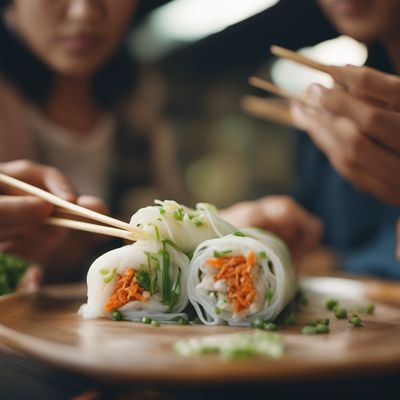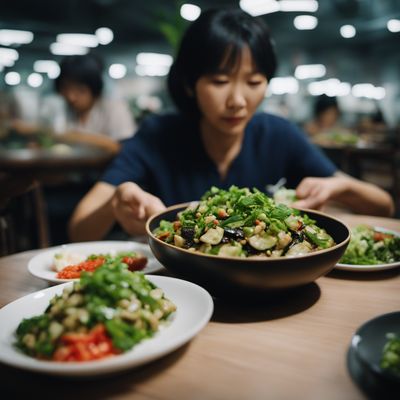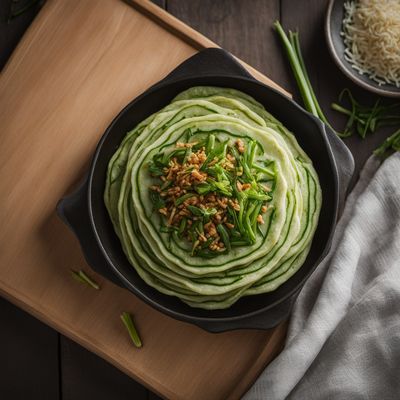
Recipe
Korean-style Spring Rolls
Kimchi-infused Spring Rolls: A Korean Twist on a Classic
4.8 out of 5
In Korean cuisine, spring rolls are a popular appetizer known for their fresh and vibrant flavors. This recipe takes inspiration from the traditional Chinese spring rolls and adds a Korean twist by incorporating kimchi, a staple in Korean cuisine. The result is a delightful combination of crispy vegetables, savory fillings, and a hint of tangy spiciness.
Metadata
Preparation time
20 minutes
Cooking time
10 minutes
Total time
30 minutes
Yields
4 servings
Preparation difficulty
Easy
Suitable for
Vegetarian, Vegan, Dairy-free, Nut-free, Gluten-free (if using gluten-free spring roll wrappers)
Allergens
Soy (in the soy sauce), Sesame (in the sesame oil)
Not suitable for
Meat-based diets
Ingredients
While the Chinese version of spring rolls typically use a variety of vegetables and meat as fillings, the Korean-style spring rolls focus on incorporating kimchi for its unique flavor. Additionally, the dipping sauce for Korean spring rolls often includes ingredients like gochujang (Korean chili paste) and sesame oil, which add a distinct Korean taste. We alse have the original recipe for Spring Rolls, so you can check it out.
-
10 spring roll wrappers 10 spring roll wrappers
-
1 cup (235ml) kimchi, finely chopped 1 cup (235ml) kimchi, finely chopped
-
1 cup (150g) carrots, julienned 1 cup (150g) carrots, julienned
-
1 cup (150g) cucumber, julienned 1 cup (150g) cucumber, julienned
-
1 cup (150g) bean sprouts 1 cup (150g) bean sprouts
-
1 cup (150g) cooked glass noodles 1 cup (150g) cooked glass noodles
-
1 tablespoon soy sauce 1 tablespoon soy sauce
-
1 tablespoon sesame oil 1 tablespoon sesame oil
-
1 teaspoon sugar 1 teaspoon sugar
-
Vegetable oil, for frying Vegetable oil, for frying
Nutrition
- Calories (kcal / KJ): 180 kcal / 753 KJ
- Fat (total, saturated): 5g, 1g
- Carbohydrates (total, sugars): 30g, 5g
- Protein: 4g
- Fiber: 3g
- Salt: 1g
Preparation
-
1.In a large bowl, combine the chopped kimchi, carrots, cucumber, bean sprouts, and cooked glass noodles.
-
2.In a small bowl, mix together the soy sauce, sesame oil, and sugar. Pour the mixture over the vegetable and noodle mixture, and toss until well combined.
-
3.Take one spring roll wrapper and place it on a clean surface. Spoon about 2 tablespoons of the filling onto the center of the wrapper.
-
4.Fold the bottom edge of the wrapper over the filling, then fold in the sides. Roll the wrapper tightly, sealing the edges with a bit of water.
-
5.Repeat the process with the remaining wrappers and filling.
-
6.Heat vegetable oil in a deep pan or wok over medium heat. Fry the spring rolls until golden brown and crispy, about 3-4 minutes per side. Drain on paper towels to remove excess oil.
-
7.Serve the Korean-style spring rolls hot with a dipping sauce of your choice.
Treat your ingredients with care...
- Kimchi — Make sure to finely chop the kimchi to ensure it blends well with the other ingredients.
- Glass noodles — Cook the glass noodles according to the package instructions, then rinse with cold water and drain before adding them to the filling mixture.
- Spring roll wrappers — Keep the wrappers covered with a damp cloth to prevent them from drying out while assembling the spring rolls.
- Bean sprouts — Blanch the bean sprouts in boiling water for a minute, then rinse with cold water and drain before adding them to the filling mixture.
- Carrots and cucumber — Julienne the carrots and cucumber into thin, matchstick-like strips for a uniform filling.
Tips & Tricks
- To make the spring rolls extra crispy, you can double fry them. After the initial frying, let them cool for a few minutes, then fry them again until they turn golden brown.
- Experiment with different dipping sauces such as a combination of gochujang, soy sauce, and vinegar for a tangy kick.
- If you prefer a milder flavor, you can rinse the kimchi before chopping it to reduce its spiciness.
- Feel free to add other vegetables or proteins to the filling, such as mushrooms, tofu, or cooked shrimp, to customize the spring rolls to your liking.
- Serve the spring rolls immediately after frying to enjoy their crispy texture.
Serving advice
Serve the Korean-style spring rolls as an appetizer or as part of a Korean-inspired meal. They pair well with a variety of dipping sauces, such as soy sauce, gochujang, or a combination of both. Garnish with sesame seeds and sliced green onions for an extra touch of flavor and presentation.
Presentation advice
Arrange the spring rolls on a platter or individual plates, and garnish with fresh herbs like cilantro or mint leaves for a pop of color. Serve them alongside the dipping sauce(s) and additional kimchi for a complete Korean culinary experience.
More recipes...
More Chinese cuisine dishes » Browse all

Rice Noodle Roll
Rice noodle rolls are a popular Chinese dish that consists of steamed rice noodle sheets filled with various ingredients.

Guaiwei
Guaiwei sauce
Guaiwei is a spicy Sichuan dish that is made with beef or lamb and a variety of spices, including Sichuan peppercorns, chili peppers, and garlic....

Liang ban qie zi
Cold Eggplant Salad
Liang ban qie zi is a traditional Chinese dish that combines the freshness of cucumbers with the spiciness of chili oil. It is a great dish for...
More Korean cuisine dishes » Browse all

Yakgwa
Yakgwa is a traditional Korean sweet that is made from wheat flour, honey, and sesame oil. It is often served during festivals and special occasions.

Gim gui
Roasted Seaweed
Gim gui is a Korean dish made from grilled seaweed.

Jumulleok
Jumulleok is a traditional Korean dish that is made with marinated beef that is grilled on skewers. The beef is typically marinated in a mixture...








